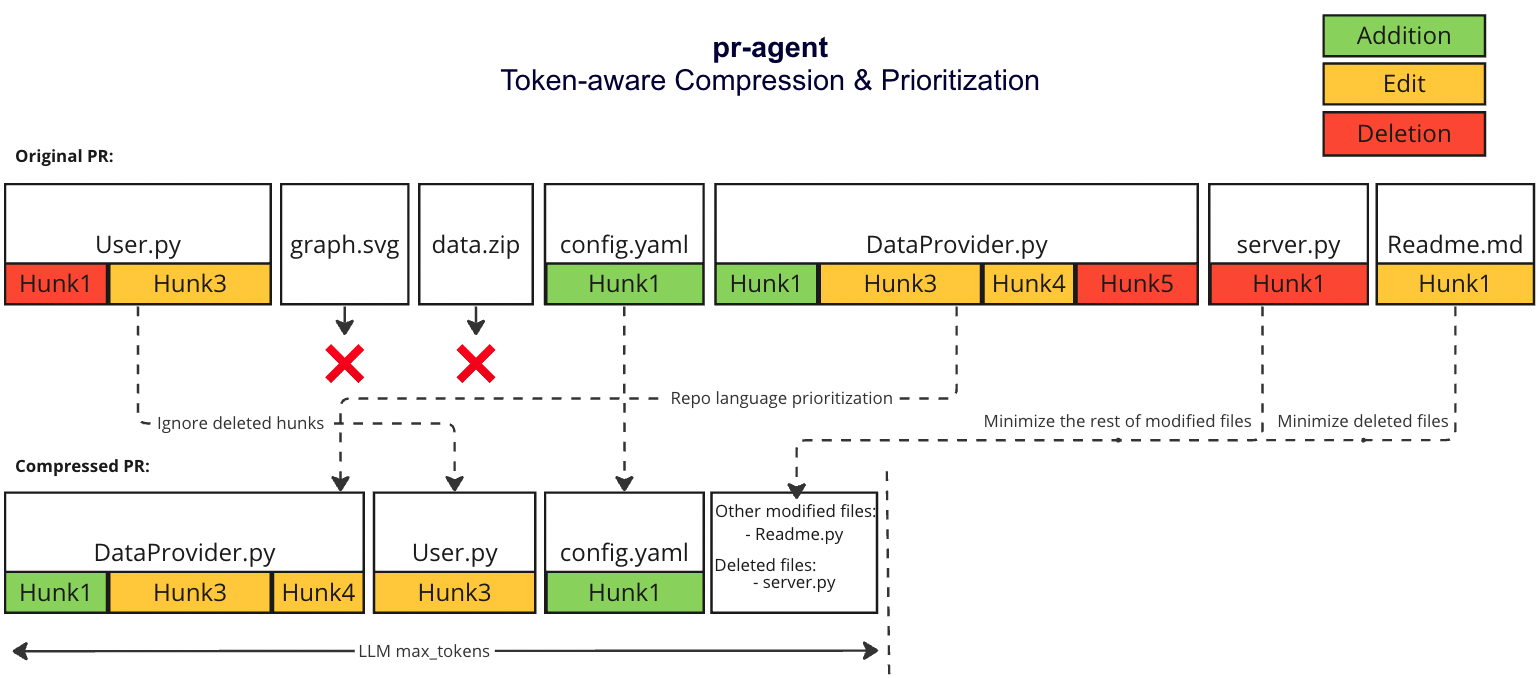mirror of
https://github.com/qodo-ai/pr-agent.git
synced 2025-07-05 05:10:38 +08:00
48 lines
2.4 KiB
Markdown
48 lines
2.4 KiB
Markdown
|
|
|
||
|
|
## Overview - PR Compression Strategy
|
||
|
|
There are two scenarios:
|
||
|
|
|
||
|
|
1. The PR is small enough to fit in a single prompt (including system and user prompt)
|
||
|
|
2. The PR is too large to fit in a single prompt (including system and user prompt)
|
||
|
|
|
||
|
|
For both scenarios, we first use the following strategy
|
||
|
|
|
||
|
|
#### Repo language prioritization strategy
|
||
|
|
We prioritize the languages of the repo based on the following criteria:
|
||
|
|
|
||
|
|
1. Exclude binary files and non code files (e.g. images, pdfs, etc)
|
||
|
|
2. Given the main languages used in the repo
|
||
|
|
3. We sort the PR files by the most common languages in the repo (in descending order):
|
||
|
|
* ```[[file.py, file2.py],[file3.js, file4.jsx],[readme.md]]```
|
||
|
|
|
||
|
|
|
||
|
|
### Small PR
|
||
|
|
In this case, we can fit the entire PR in a single prompt:
|
||
|
|
1. Exclude binary files and non code files (e.g. images, pdfs, etc)
|
||
|
|
2. We Expand the surrounding context of each patch to 3 lines above and below the patch
|
||
|
|
|
||
|
|
### Large PR
|
||
|
|
|
||
|
|
#### Motivation
|
||
|
|
Pull Requests can be very long and contain a lot of information with varying degree of relevance to the pr-agent.
|
||
|
|
We want to be able to pack as much information as possible in a single LMM prompt, while keeping the information relevant to the pr-agent.
|
||
|
|
|
||
|
|
#### Compression strategy
|
||
|
|
We prioritize additions over deletions:
|
||
|
|
- Combine all deleted files into a single list (`deleted files`)
|
||
|
|
- File patches are a list of hunks, remove all hunks of type deletion-only from the hunks in the file patch
|
||
|
|
|
||
|
|
#### Adaptive and token-aware file patch fitting
|
||
|
|
We use [tiktoken](https://github.com/openai/tiktoken) to tokenize the patches after the modifications described above, and we use the following strategy to fit the patches into the prompt:
|
||
|
|
|
||
|
|
1. Within each language we sort the files by the number of tokens in the file (in descending order):
|
||
|
|
- ```[[file2.py, file.py],[file4.jsx, file3.js],[readme.md]]```
|
||
|
|
2. Iterate through the patches in the order described above
|
||
|
|
3. Add the patches to the prompt until the prompt reaches a certain buffer from the max token length
|
||
|
|
4. If there are still patches left, add the remaining patches as a list called `other modified files` to the prompt until the prompt reaches the max token length (hard stop), skip the rest of the patches.
|
||
|
|
5. If we haven't reached the max token length, add the `deleted files` to the prompt until the prompt reaches the max token length (hard stop), skip the rest of the patches.
|
||
|
|
|
||
|
|
#### Example
|
||
|
|
|
||
|
|
{width=768}
|